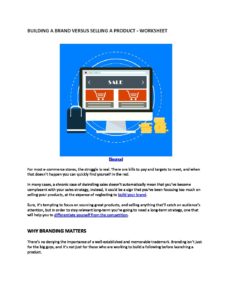Also known as: Selling your brand, not the product!
For most e-commerce stores, the struggle to make it is real. There are bills to pay and targets to meet, and when that doesn’t happen you can quickly find yourself in the red, losing money, struggling to stay afloat, and trying to figure out where it all went wrong.
But the truth is that for most of us, when sales are down, it’s easy to shift the blame onto the wrong issue. “Maybe I’m just a bad salesman,” you think, “Or maybe I landed on a dud product.”
In many cases, though, a chronic case of dwindling sales doesn’t automatically mean that you’ve become complacent with your sales strategy, instead, it could be a sign that you’ve been focusing too much on selling your products, at the expense of neglecting to build your brand.
Sure, it’s tempting to focus on sourcing great products, and selling anything that’ll catch an audience’s attention –and this strategy will work –for a while, but in order to stay relevant, you’re going to need a long-term strategy, one that will help you to differentiate yourself from the competition.
Why Branding Matters
As a webstore, though, does your brand really matter?
Definitely!
People are far more likely to buy from brands that they know and love. The reverse is true as well, with consumers today increasingly likely to boycott brands that don’t share their social beliefs.
But it’s not just the hearts and minds of customers that e-commerce stores need to capture; the battle for market share is becoming increasingly challenging for another reason as well: choice. Each and every day, the competition gets a little bit stronger.
As new competitors enter the e-commerce sphere, and more efficient manufacturing and fulfillment processes take hold, it’s becoming increasingly important for companies to start focusing on differentiating, and growing their brand.
Naturally, this raises the question: how do you go about growing your brand? And which comes first, the product or the audience?
Many startups today, are taking an audience-first approach. This means focusing on growing a community around their brand before they spend money on product development and advertising.
However, if you’re anything like most of us, chances are you may have taken a product-first approach. You happened to find something that sells –and that’s great!
No matter which approach you took, though, there’s no denying the importance of a well-established and memorable trademark. Branding isn’t just for the big guys, and it’s not just for those who are working to build a following before launching a product.
Branding is important for anyone who wants to experience long-term success. According to Re Perez, a former Fortune 500 Brand Consultant and CEO of BRANDING FOR THE PEOPLE, branding is about creating a desired perception over time (not just about selling a product or service). In fact, it’s easy to get someone to buy from you once or twice.
However, in the game of creating a sustainable business, you need to build a brand that creates raving fans and loyal customers. Marketing helps you eat during the day. Branding helps you sleep at night.
In the long-term, branding can also increase your products’ value, or influence your audience’s perception of value. If you’ve built up a reputation, and as your products become more in-demand, you’ll be able to command a better price for them. You see this playing out all the time when it comes to name-brand products versus generic. In some cases, the products are exactly the same but the branded ones often go for a lot more.
If you want to grow your business sustainably, and you’re in it for the long haul, you’re going to want to set yourself up as an industry leader. You’re going to want to tap into your target audience, discover who they are and what makes them tick. You’re going to want to create a voice, an approach, a message, and a look that your audience can recognize immediately. You’re going to want to develop a memorable brand.
Success: A Long-Term Approach

“Ok,” you might be thinking now. “That’s all well and good, but why should I bother focusing on branding, what’s wrong with just finding a great product, and simply selling that?”
We all have our flagship products, our bestsellers that drive the majority of our sales. But I’m not talking about a short-lived stint of success. What I’m talking about is staying power. When it comes down to it, most successful companies last because of innovation and the ability to change –not because they simply stuck with one product for decades.
It makes sense when you think about it. Consider Apple’s advancements from computers to iPods and iPhones; or the fact that Sony advanced from the early days when it used to sell rice cookers, or Nokia’s humble beginnings as a paper mill.
A successful long-term company lies in their ability to keep up with their customer’s changing needs and preferences. That’s why you’ll want to focus on creating a brand –rather than just one single product.
This is the case for big names like Apple, and companies in smaller, more niche industries as well.
With this in mind, let’s take a look at branding, what it is exactly, and then delve into how you can develop your brand to help increase your market share, leading to increased visibility and sales.
What is Branding?
Throw out the word, ‘branding,’ and chances are a logo or company color scheme comes to mind. But while visual consistency is indeed an important part of a brand’s visibility, there’s more to it than that.
Your brand, at its core, can be defined as “your customers’ perception of you.” And like it or not, there’s a good chance that your customer already has a perception of some type, of you already.

First, let’s take a look at how the megabrands market. To them, it’s not just about peddling generic products, but working to create a lasting impression. It’s less about hawking a product, and more about selling the experience or emotion or solution that the product provides.
Starbucks doesn’t just sell coffee, they sell Starbucks, when you buy an iPhone, you’re not just getting a phone, but an Apple product. Successful branding involves finding a way to create or distribute stand-out products –but more than that it’s about working to create a name that will pop into your customer’s head when they want something that fits that description.
You want to be synonymous with the type of products or solutions that your target customers are in the market for.
Doing this successfully involves knowing your customer, knowing their wants, their dreams, their problems and pain-points, their location, their purchasing habits, and preferences, and finally, knowing how your company can address or solve their problems –and communicating that effectively.

Get our Building a Brand Versus Selling a Product Worksheet delivered right to your inbox.
Enter: branding.
Branding isn’t a one-time endeavor; instead there are really three different aspects of branding –your brand itself, your strategy, and your visual identity. Each of these work together to help you grow your company, enabling you to become a household name, get the word out about what you have to offer, and continue to grow and develop to bring new offerings to the table; allowing you to stay relevant as your customers’ needs and preferences change.
Here’s a look at all three now:
Your Brand Itself
Your brand is the perception that your customers have of you. This is formulated through their experience with you, as well as the promises that you make. When growing your brand, you’ll want to put yourself in your audience’s shoes. First, determine who your audience is, then start thinking about their needs –and how you can go about creating or selling a product that addresses them.
Your Brand Strategy
Next is your brand strategy, or positioning statement. As the well-known saying goes, if you try to be known for everything, you’ll end up being known for nothing. Instead of casting your net too wide, and trying to market to everyone, it’s a good idea to narrow your focus a bit and zero in on your exact place in the market.
This is also the stage of the game where you think about your messaging, your marketing, and your approach. How will you connect with your target audience, show them what you have to offer, and convince them to try it?
Your Visual Identity
Finally, the most well-known part of branding; your visual identity is the visual expression of your brand, and is how you appear online and in print. This includes your logo, graphics, images, colors, your company’s voice, and more. This stage of the game is all about creating a recognizable image.
If you stand for something, and can create a consistent identity, then you’ll be able to move forward with building a relationship with your customers. Having a clear and memorable identity will help them to filter out the barrage of information that’s coming their way, enabling them to recognize your brand.
At the end of the day, remember: it’s important to focus on selling your brand, not just your product.
Defining Your Brand
Creating and defining your brand requires an initial investment of time, and will involve asking yourself some tough questions.
If you haven’t done so already, here’s a look at some things that you’ll want to ask as you begin carving out your brand.
- What is my company’s mission?
- What do we stand for?
- Who is my target customer?
- What interests them?
- What fears, problems, or frustrations are they facing?
- What issues or problems do my products seek to solve?
- What benefits do my products offer that others don’t?
- What type of company will I be? What voice will I have? Friendly, approachable, likeable, understanding, rugged, professional, upscale, elite, exclusive, etc.?
Ensure that you don’t operate on assumptions; instead, take the time to learn about the needs, wants, and habits of your prospective customers.
Practical Tips for Visual Branding
After you’ve defined your brand, you can then start getting the word out. Here’s a look at creating consistency in your marketing messages.

- Get a great logo. Something simple and immediately recognizable.
- Create a slogan or tagline.
- Create brand standards for your marketing materials. Use consistent colors.
- Take the time to create, and write down your brand messaging. What do you want to communicate about your brand?
- Integrate your brand with every aspect of your business. Ensure consistency in everything from how you provide customer service, to what your team wears, and your email sign-offs.
- Likewise, you should create a company voice that should come through in all written and spoken communication.
- Stay true to your brand. Deliver on your promises.
Tips for Implementing a Marketing System to Get Your Company Noticed
Of course, at the end of the day, the best brand in the world doesn’t mean a thing if it can’t get publicity. While creating a strong brand is the first step of the process, once you’ve defined your brand you’ll want to set to work developing a marketing system that will get your company noticed. For e-commerce stores today, successfully getting the word out usually involves a combination of the following:
- Advertising –social media, PPC, etc.
- Levering social media
- Enlisting social media influencers
- Optimizing your online shopping platform; Amazon, Shopify or other account
- Leveraging forums
- Creating blog content: helpful and informative blog posts
- Conducting blog outreach: creating posts that feature people with audiences
- Email marketing, and working to grow your email mailing list
Finally, as Andy Dunn, the founder of Bonobos says, “At the end of the day, you’re not building an e-commerce company, you’re building a brand that has e-commerce as its core distribution channel.”
That’s important to remember as we get lost in the day-to-day work of product listings and order fulfillment. Growing your brand will usually require a significant time investment, but it’s something that’s worth doing.
Not only will it help you to reach your target audience more effectively, but it will also allow you to work towards creating a foundation on which you can continue to expand your product offerings; enabling you to stay fluid and relevant, and ultimately helping your company to stand the test of time.
E-commerce stores and startups –which came first for you; the product or the audience? How are you working to grow your brand?

Get our Building a Brand Versus Selling a Product Worksheet delivered right to your inbox.






